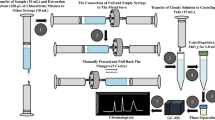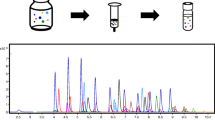Abstract
A large screening of around 1,000 emerging contaminants, focused on licit and illicit drugs and their metabolites, has been made in urban wastewaters (both influent and effluent) and surface waters from the area of Bogotá, Colombia. After a simple generic solid-phase extraction (SPE) step with Oasis hydrophilic-lipophilic balanced (HLB) cartridges, analyses were made by ultra high-performance liquid chromatography coupled to quadrupole time-of-flight mass spectrometry (UHPLC-QTOF MS) under MSE mode (sequential acquisition of mass spectra at low energy (LE) and high collision energy (HE)). Accurate mass measurements and the information provided by MSE on the presence of the (de)protonated molecule and fragment ions allowed the reliable identification of the compounds detected, even without reference standards being available in some cases (tentative identification). The compounds most frequently found were acetaminophen/paracetamol, carbamazepine and its dihydro-dihydroxylated metabolite, clarithromycin, diclofenac, ibuprofen, gemfibrozil, lincomycin, losartan, valsartan, the two metabolites of metamizole (4-acetamido-antipyrine and 4-formylamino-antipyrine), sucralose, and cocaine and its main metabolite benzoylecgonine. Caffeine, the sweetener saccharin, and two hydroxylated metabolites of losartan were tentatively identified in almost all samples analyzed. Pharmaceutical lidocaine was tentatively identified and subsequently confirmed with reference standard. For the first time, a general overview of the occurrence of drugs and their metabolites in the aquatic environment of Colombia has been reported. In the near future, target methodologies, typically based on liquid chromatography coupled to tandem mass spectrometry (LC-MS/MS), will need to be set up for accurate and sensitive quantification of the contaminants selected on the basis on the information provided in the present paper.





Similar content being viewed by others
References
Pal A, He Y, Jekel M, Reinhard M, Yew-Hoon Gin K (2014) Emerging contaminants of public health significance as water quality indicator compounds in the urban water cycle. Environ Int 71:46–62
Richardson SD, Ternes TA (2014) Water analysis: emerging contaminants and current issues. Anal Chem 86:2813–2848
Fatta-Kassinos D, Meric S, Nikolaou A (2011) Pharmaceutical residues in environmental waters and wastewater: current state of knowledge and future research. Anal Bioanal Chem 399:251–275
Gros M, Petrovic M, Ginebreda A, Barceló D (2010) Removal of pharmaceuticals during wastewater treatment and environmental risk assessment using hazard indexes. Environ Int 36:15–26
Thomas KV, Araújo da Silva FM, Langford KH, Leão de Souza A, Nizzeto L, Waichman AV (2014) Screening for selected human pharmaceuticals and cocaine in the urban streams of Manaus, Amazonas, Brazil. JAWRA 50:302–308
De Paula VS, Diniz-Mendes L, Villar LM, Luz SLB, Silva LA, Jesus MS, da Silva NMVS, Gaspar AMC (2007) Hepatitis A virus in environmental water samples from the Amazon Basin. Water Res 41:1169–1176
Montagner CC, Jardim WF (2011) Spatial and seasonal variations of pharmaceuticals and endocrine disruptors in the Atibaia River, São Paulo State (Brazil). J Braz Chem Soc 22:1452–1462
Gracia-Lor E, Martínez M, Sancho JV, Peñuela G, Hernández F (2012) Multi-class determination of personal care products and pharmaceuticals in environmental and wastewater samples by ultra-high performance liquid-chromatography-tandem mass spectrometry. Talanta 99:1011–1023
Boxall ABA, Rudd MA, Brooks BW, Caldwell DJ, Choi K, Hickmann S, Innes E, Ostapyk K, Staveley JP, Verslycke T, Ankley GT, Beazley KF, Belanger SE, Berninger JP, Carriquiriborde P, Coors A, DeLeo PC, Dyer SD, Ericson JF, Gagné F, Giesy JP, Gouin T, Hallstrom L, Karlsson MV, Larsson DGJ, Lazorchak JM, Mastrocco F, McLaughlin A, McMaster ME, Meyerhoff RD, Moore R, Parrott JL, Snape JR, Murray-Smith R, Servos MR, Sibley PK, Straub JO, Szabo ND, Topp E, Tetreault GR, Trudeau VL, van der Kraak G (2012) Pharmaceuticals and personal care products in the environment: what are the big questions? Environ Health Perspect 120:1221–1229
Schymanski EL, Singer HP, Longrée P, Loos M, Ruff M, Stravs MA, Ripollés Vidal C, Hollender J (2014) Strategies to characterize polar organic contamination in wastewater: exploring the capability of high resolution mass spectrometry. Environ Sci Technol 48:1811–1818
Hernández F, Ibáñez M, Bade R, Bijlsma L, Sancho JV (2014) Investigation of pharmaceuticals and illicit drugs in waters by liquid chromatography-high-resolution mass spectrometry. Trends Anal Chem 63:140–157
Díaz R, Ibáñez M, Sancho JV, Hernández F (2012) Target and non-target screening strategies for organic contaminants, residues and illicit substances in food, environmental and human biological samples by UHPLC-QTOF-MS. Anal Methods 4:196–209
Hernández F, Bijlsma L, Sancho JV, Díaz R, Ibáñez M (2011) Rapid wide-scope screening of drugs of abuse, prescription drugs with potential for abuse and their metabolites in influent and effluent urban wastewater by ultrahigh pressure liquid chromatography–quadrupole-time-of-flight-mass spectrometry. Anal Chim Acta 684:96–106
Laks S, Pelander A, Vuori E, Ali-Toppa E, Sippola E, Ojanpera I (2004) Analysis of street drugs in seized material without primary reference standards. Anal Chem 76:7375–7379
Hernández F, Portolés T, Ibáñez M, Bustos-López MC, Díaz R, Botero-Coy AM, Fuentes CL, Peñuela G (2012) Use of time-of-flight mass spectrometry for large screening of organic pollutants in surface waters and soils from a rice production area in Colombia. Sci Total Environ 439:249–259
MassBank Norman. High resolution mass spectral database. http://massbank.ufz.de/MassBank/. Accessed 29 Jan 2015
Metlin. Metabolite and tandem MS database. http://metlin.scripps.edu/index.php. Accessed 29 Jan 2015
Schymanski EL, Jeon J, Gulde R, Fenner K, Ruff M, Singer HP, Hollender J (2014) Identifying small molecules via high resolution mass spectrometry: communicating confidence. Environ Sci Technol 48:2097–2098
Hernández F, Ibáñez M, Gracia-Lor E, Sancho JV (2011) Retrospective LC–QTOF-MS analysis searching for pharmaceutical metabolites in urban wastewater. J Sep Sci 34:3517–3526
López JJ, Dennis R, Moscoso SM (2009) Estudio sobre la Automedicación en una localidad de Bogotá. Revista de Salud Pública 11:432–442
Rodríguez J, Ruiz F, Peñaloza E, Eslava J, Gómez LC, Sanchez H, Amaya JL, Arenas R, Botiva Y (2009) Encuesta Nacional de Salud 2007. ISBN 978-958-716-220-2
Machado-Alba JE, González-Santos DM (2009) Dispensación de antibióticos de uso ambulatorio en una población colombiana. Revista de Salud Pública 11:734–744
United Nations Office on Drugs and Crime. https://www.unodc.org/documents/colombia/2014/Julio/Estudio_de_Consumo_UNODC.pdf. Accessed 26 Jan 2015
Bijlsma L, Beltrán E, Boix C, Sancho JV, Hernández F (2014) Improvements in analytical methodology for the determination of frequently consumed illicit drugs in urban wastewater. Anal Bioanal Chem 406:4261–4272
Ort C, van Nuijs ALN, Berset J-D, Bijlsma L, Castiglioni S, Covaci A, de Voogt P, Emke E, Fatta-Kassinos D, Griffiths P, Hernández F, González-Mariño I, Grabic R, Kasprzyk-Hordern B, Mastroianni N, Meierjohann A, Nefau T, Östman M, Pico Y, Racamonde I, Reid M, Slobodnik J, Terzic S, Thomaidis N, Thomas KV (2014) Spatial differences and temporal changes in illicit drug use in Europe quantified by wastewater analysis. Addiction 109:1338–1352
Pedrouzo M, Borrull F, Pocurull E, Marcé RM (2011) Drugs of abuse and their metabolites in waste and surface waters by liquid chromatography-tandem mass spectrometry. J Sep Sci 34:1091–1101
Ibáñez M, Pozo OJ, Sancho JV, Orengo T, Haro G, Hernández F (2015) Discovering human urinary metabolites of methylenedioxypyrovalerone (MDPV) by liquid chromatography/quadrupole time-of-flight mass spectrometry. Forensic Toxicol submitted
Bijlsma L, Boix C, Niesen WMA, Ibáñez M, Sancho JV, Hernández F (2013) Investigation of degradation products of cocaine and benzoylecgonine in the aquatic environment. Sci Total Environ 443:200–208
PGKB Pharmacogenomics. https://www.pharmgkb.org/pathway/PA164713428#. Accessed 29 Jan 2015
Acknowledgments
The authors are very grateful to Nubia Irley León and colleagues of Acueducto de Bogotá (Bogotá, Colombia) for providing wastewater samples, Natalia Gonzalez for preparing the wastewater samples, Jose Roberto Vergas for collecting and processing the surface water samples, and Carlos Sales Martinez for making Fig. 1. Furthermore, the collaboration of Juan V. Sancho and Oscar J. Pozo of the Hospital del Mar Medical Research Institute, Bioanalysis Research Group (Barcelona, Spain), for the interpretation of the fragmentation pathways of the losartan metabolites is highly appreciated.
This work has been developed under financial support provided by the Plan Nacional de I+D+I, Ministerio de Economía y Competitividad (Project ref. CTQ2012-36189) and the University Antonio Nariño, Colombia (Project ref. 20141082). The authors also acknowledge the financial support from Generalitat Valenciana (Group of Excellence Prometeo 2009/054, Prometeo II 2014/023; Collaborative Research on Environment and Food Safety ISIC/2012/016).
R. Bade acknowledges the European Union for his Early Stage Researcher (ESR) contract as part of the EU-International Training Network SEWPROF (Marie Curie- PEOPLE Grant #317205).
Author information
Authors and Affiliations
Corresponding author
Additional information
Published in the topical collection High-Resolution Mass Spectrometry in Food and Environmental Analysis with guest editor Aldo Laganà.
Electronic supplementary material
Below is the link to the electronic supplementary material.
ESM 1
In this section, a table is shown of the human and veterinary pharmaceuticals including metabolites (Table S1), X-ray agents (Table S2), UV filters (Table S3), preservatives (Table S4), sweeteners (Table S5), and illicit drugs including metabolites (Table S6) studied. (PDF 254 kb)
Rights and permissions
About this article
Cite this article
Hernández, F., Ibáñez, M., Botero-Coy, AM. et al. LC-QTOF MS screening of more than 1,000 licit and illicit drugs and their metabolites in wastewater and surface waters from the area of Bogotá, Colombia. Anal Bioanal Chem 407, 6405–6416 (2015). https://doi.org/10.1007/s00216-015-8796-x
Received:
Revised:
Accepted:
Published:
Issue Date:
DOI: https://doi.org/10.1007/s00216-015-8796-x




